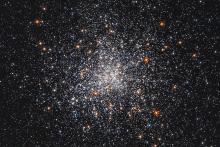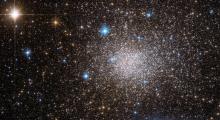Listen to today's episode of StarDate on the web the same day it airs in high-quality streaming audio without any extra ads or announcements. Choose a $8 one-month pass, or listen every day for a year for just $30.
You are here
Pleiades Twin
A young star cluster that may be like a smaller version of the Pleiades moves low across the sky on late-autumn evenings. Despite that comparison, though, it hasn’t received a lot of attention.
In part, that’s because of its location. Blanco 1 is in the constellation Sculptor, which is quite low in the south at nightfall. Until recent decades, there weren’t a lot of research telescopes in the southern hemisphere, so the cluster was hard to study. And even today, astronomers are still trying to figure it out.
One thing they may have locked down is its distance. The Gaia spacecraft measured several of the cluster’s stars, and came up with a distance of about 750 light-years — a good bit closer than earlier estimates.
Astronomers are still working on Blanco 1’s population, though. The cluster appears to contain several hundred stars — roughly half as many as the Pleiades. It’s also home to several dozen “failed” stars, known as brown dwarfs.
The cluster’s age is uncertain as well. But it’s probably somewhere around a hundred million years.
When you put it all together, the cluster is like a smaller “twin” of the Pleiades, which is also known as the Seven Sisters — perhaps the most famous of all star clusters. Blanco 1 is about the same age as the Pleiades, and it contains about the same mixture of stars. The stars are more spread out, though. Combined with the cluster’s distance, that makes Blanco 1 a pale replica of its larger “twin.”
Script by Damond Benningfield






